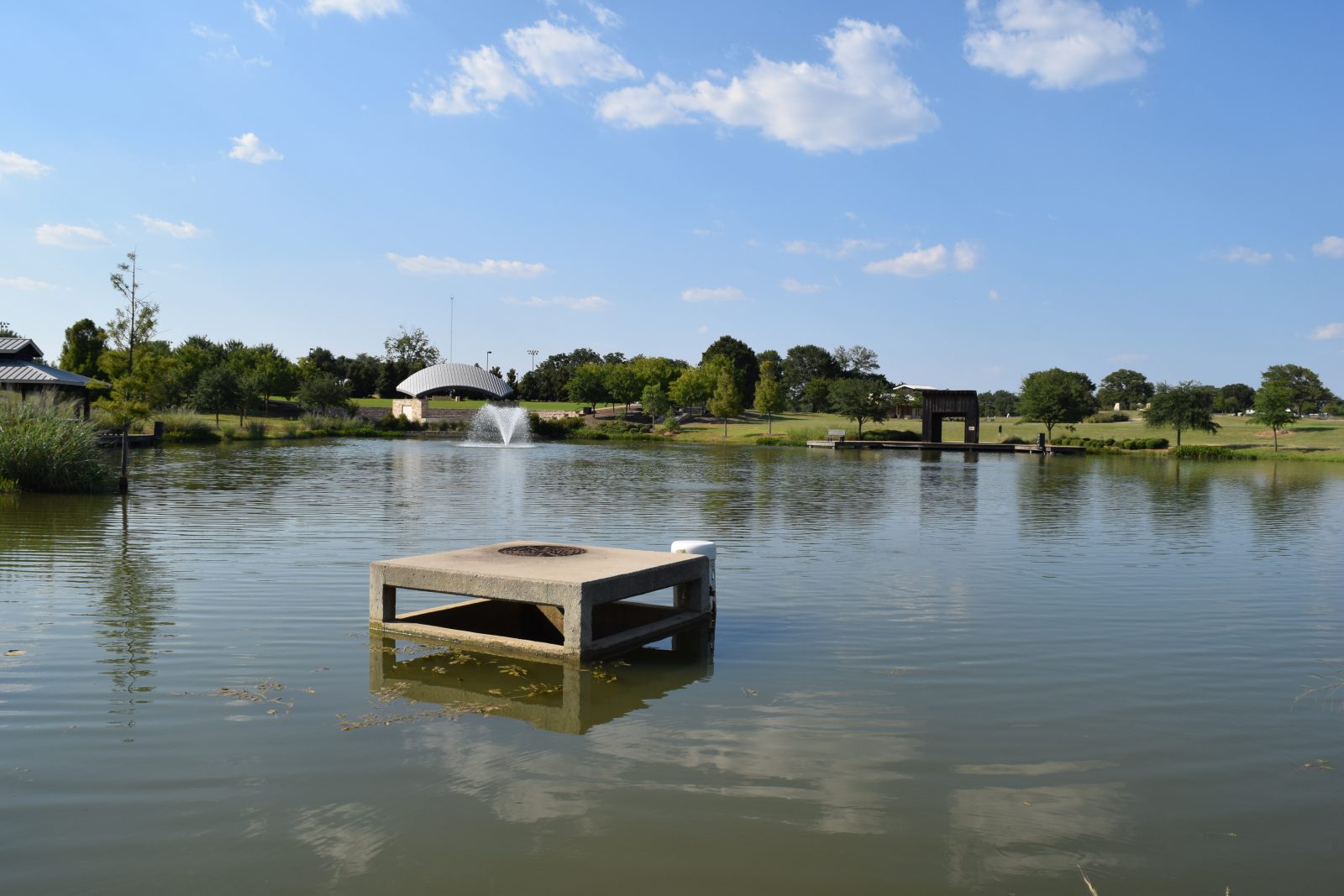
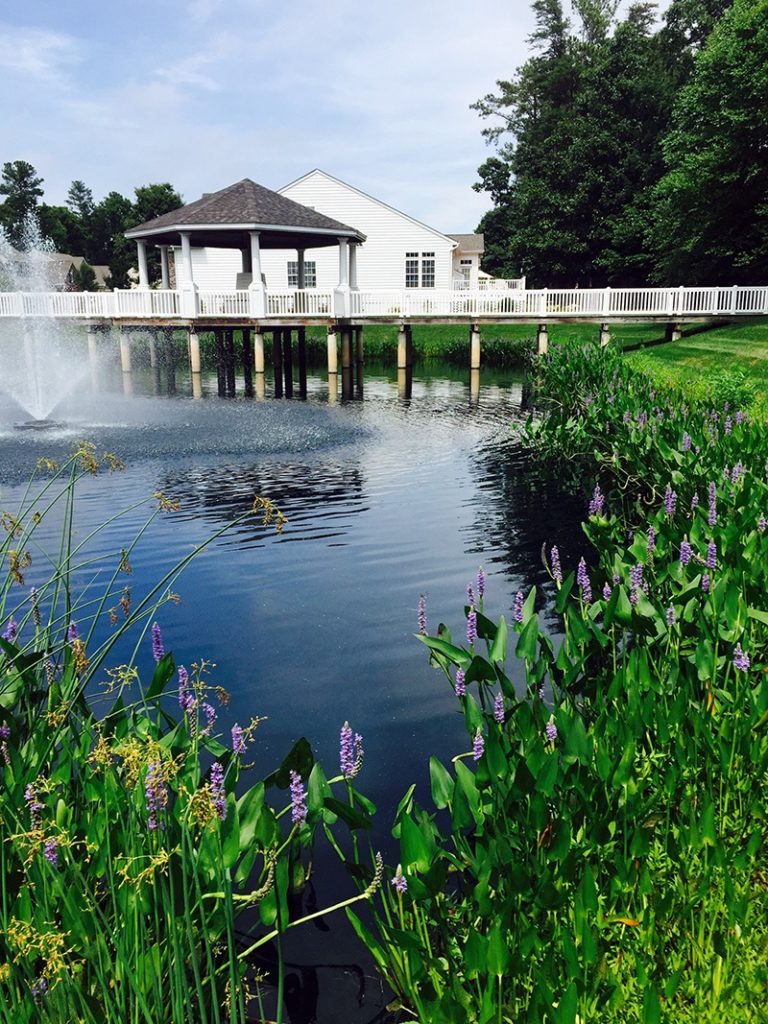
Taking it Back to the Basics: Stormwater Management Pond Parts
Experienced water quality management professionals spend years meeting with hundreds of individuals, homeowner’s associations, commercial facilities, and property managers. The largest challenge to overcome is educating the waterbody owner or manager. Stormwater management rules and regulations are a fairly new phenomenon, developed from the Clean Water Act. While certain regulations continue to evolve in stormwater management, educating any potential or current client on a stormwater facility’s function and specific design elements or parts is important. An educated client will be equipped to understand and implement a sustainable maintenance and management program or a repair/remediation program for their community, property, or commercial site.
Today, more and more stormwater management is implemented with a variety of best management practices (BMPs), such as infiltration basins, bio-infiltration areas, bio-swales, and rain gardens. However, there are still large numbers of stormwater management “wet” ponds/retention basins and “dry” ponds/detention basins. These ponds are designed to hold water, capture sediment and pollutants, and then release the water slowly to mimic run-off from the site prior to any development. Most of these “ponds” or basins have similar basic parts. Explaining these parts or design elements, why they are there, how they function, and how they should be maintained, is an important step to developing a mutual understanding with a client before moving forward with a maintenance or repair program.
The following stormwater pond parts are found in the vast majority of jurisdictions and designs:
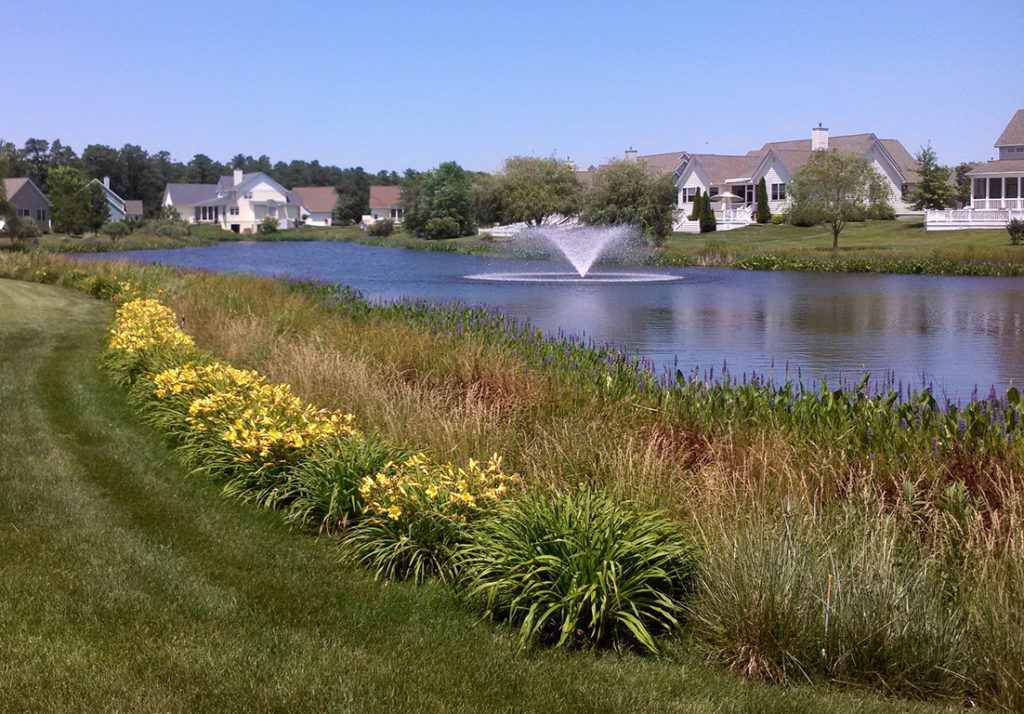
Pond Embankment:
Typically, stormwater ponds have an earthen embankment surrounding them. Part or all of the embankment can act as a dam to keep the water in the pond. Depending on the jurisdiction or size of the embankment, it may be regulated by both stormwater and dam safety regulations. These regulations are often enforced by separate regulatory organizations. It is important to become familiar to determine all the regulations that are applicable to the pond to ensure compliance. The embankment is usually sloped and should be stabilized with herbaceous vegetation and grasses.
A buffer can also be allowed to grow. Buffers can help reduce sediment and nutrient loading in the pond while providing greater stabilization for the embankment. Buffers should be composed of herbaceous vegetation, native grasses, and perennial flowers, and should be kept free of invasive species and trees. Large trees, animal burrowing, and exposed soils can lead to erosion and failure of the embankment. If the embankment is classified as a regulated dam, it may be designated with a safety classification that could entail more intensive maintenance. The pond embankment should be inspected monthly, at a minimum, and after any large rain event.
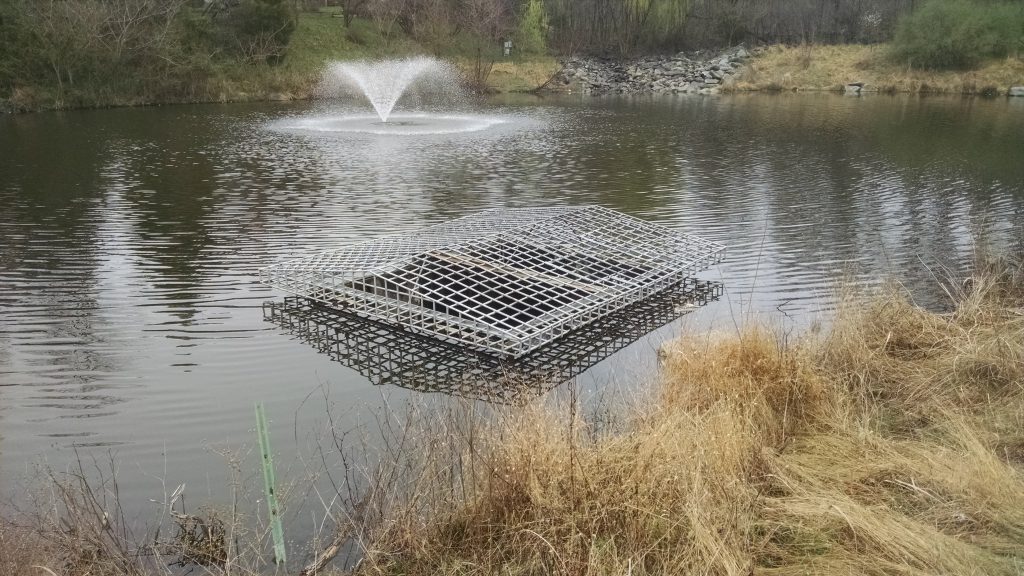
Outlet Structure:
Outlet structures are designed to hold and release the water from the stormwater pond at specific engineered rates based on the amount of rainfall or run-off draining into the basin from surrounding impervious surfaces. Newer ponds mostly have engineered concrete outlet structures, but older ponds may also have galvanized steel structures or other types of pipe risers. Outlet structures also have trash-racks on the low-flow (bottom orifice) and overflow (top of the structure). Trash racks need to be secured and kept in place. Outlets and the associated trash racks should be kept free of trash, debris, and vegetation.
It is recommended to check outlet trash racks monthly, at a minimum, and following any large rain event. They also need to be checked for any structural weaknesses or leaks that could jeopardize the function of the system. If part of a classified dam, the outlet structure may have different design and maintenance criteria that could entail more intensive or additional maintenance activities. Typically, a properly functioning outlet structure should drain the pond to back to the designed “normal pool” 24 to 48 hours after a normal rain event.
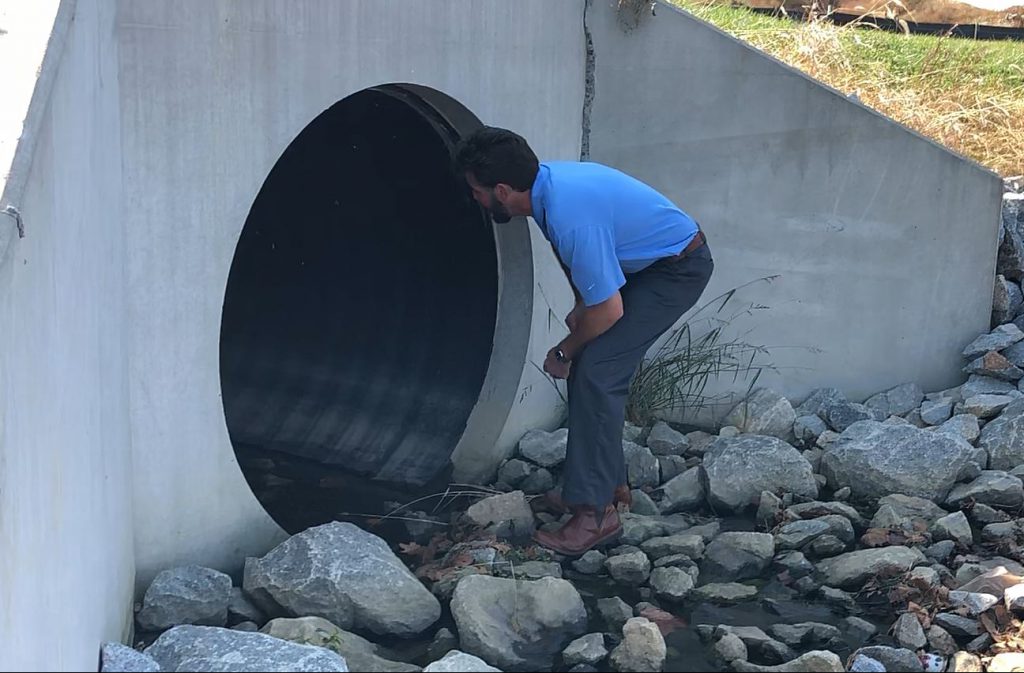
Inlets:
An inlet is any area, often a pipe, which conveys run-off from surrounding paved areas and property into the stormwater pond. Piped inlets are typically made of concrete, high-strength plastics, or galvanized steel. Inlets can also be in the form of open earthen swales typically vegetated with grass or other herbaceous perennials. Where inlets enter the pond or basin rip-rap (stone) dissipaters or aprons are often installed. Stoned areas have been designed to reduce run-off velocity to prevent erosion and catch sediment and debris before it enters the pond. The inlet should be periodically checked for sediment buildup in the pipe. The rip-rap dissipater should also be kept free of vegetation and checked for erosion or sediment build-up. Sediment build-up, unwanted vegetation, or erosion at inlet areas can cause drainage issues, reduce the lifespan of the pond and increase maintenance costs.
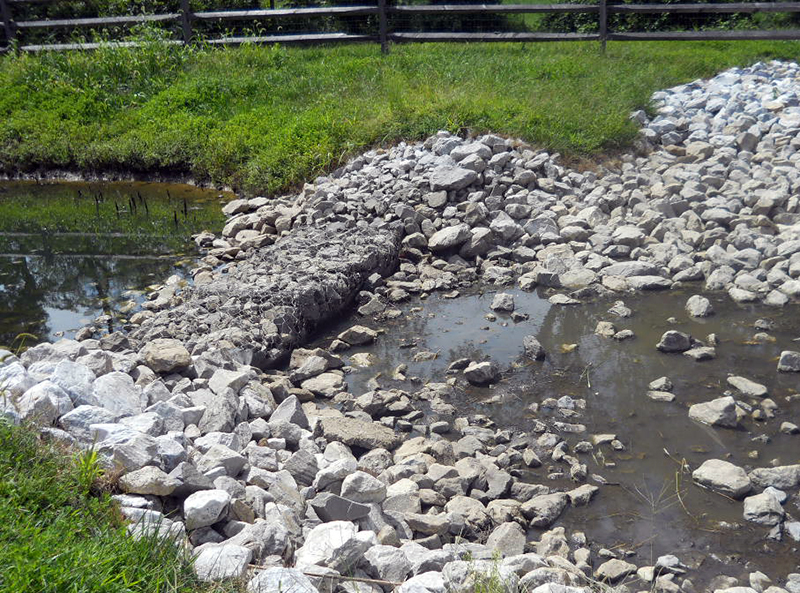
Forebay:
Forebays are typically located at inlets. They are small areas segregated from the rest of the pond by rip-rap, stone gabions or earth embankments. The purpose of a forebay is to collect sediment before it enters the rest of the pond, making maintenance and sediment removal easier. They need to be checked periodically for sediment build-up to function properly and should also be kept clear of trees and invasive vegetation.
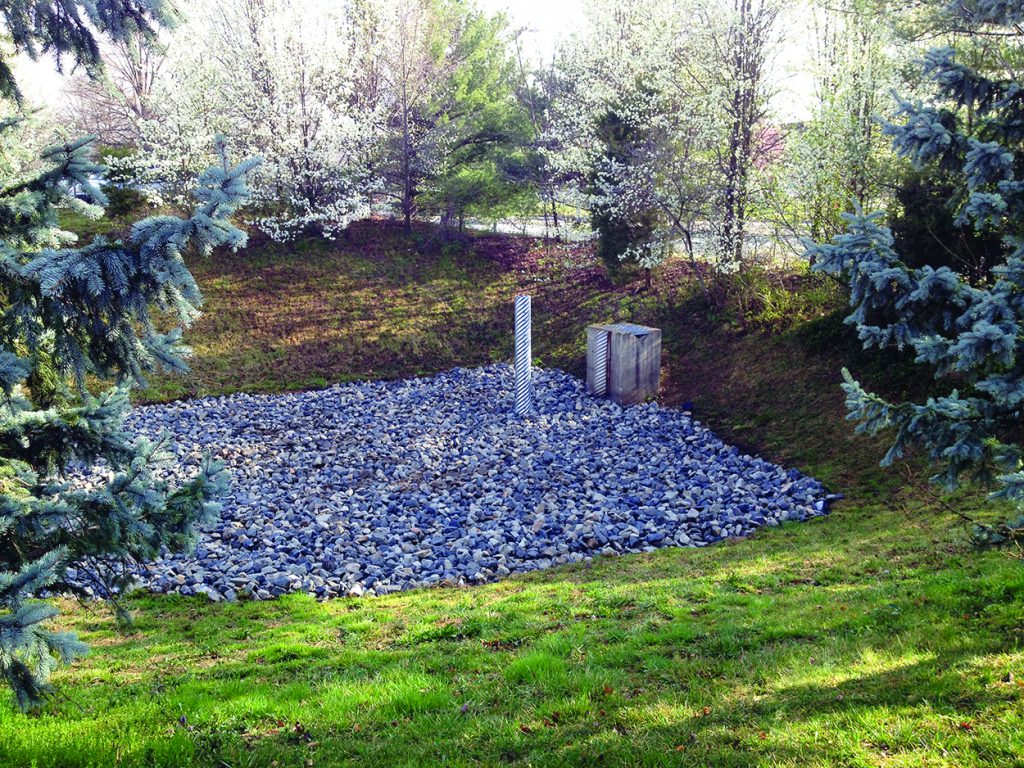
Emergency Spillway:
The emergency spillway is a cut-out at the top of the embankment where water can leave the pond during an extreme storm or rain event. These areas can be stabilized with concrete, rip-rap, or herbaceous vegetation. The emergency spillway should be kept clear of trees, sediment, animal burrows, and debris. If part of a classified dam, the emergency spillway may have different design and maintenance criteria that could entail more intensive or additional maintenance activities. They need to be checked for any erosion or structural weaknesses during regular inspections.
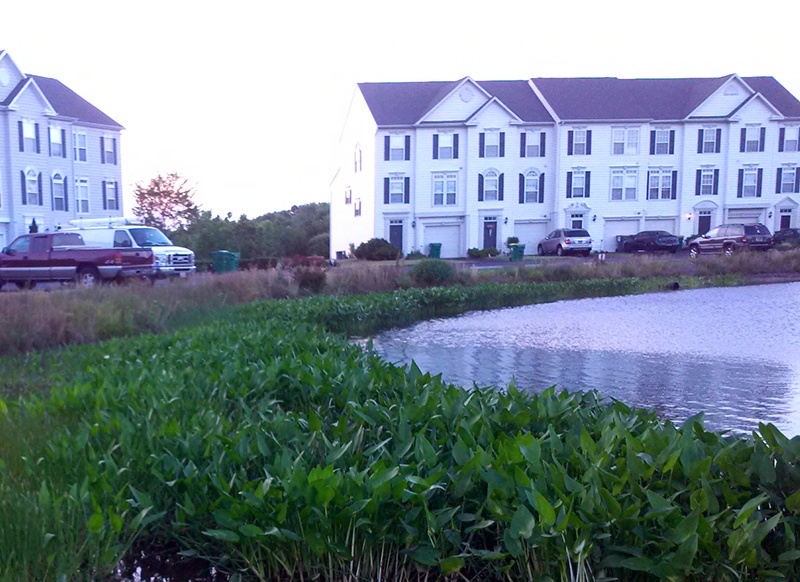
Safety Bench:
Often, an experienced pond and stormwater management professional is contacted after a stormwater pond or BMP owner or responsible party receives an inspection report from the delegated regulatory agency in their jurisdiction stating that their stormwater facility has deficiencies. Unfortunately, a regular maintenance and inspection program would have often kept their stormwater system in compliance and fully functional without the need for costly repairs. Educating the potential client on their stormwater pond parts is the first step in the process of getting the pond back in compliance. The following is a typical case study.
Case Study:
SOLitude Lake Management was contacted by a commercial property owner in Newark, DE in February of 2012. The client received an inspection report on their stormwater facility from the New Castle County Department of Special Services, the agency responsible for stormwater inspections and enforcement in the county, in July of 2011. The inspection letter highlighted multiple issues with the stormwater dry pond constructed on the site. New Castle County Department of Special Services had identified in their inspection report the following “Maintenance Needs”:
- Repair the erosion that is active around the storm sewer manhole on the embankment adjacent to the inlet pipe;
- The low flow stand has detached and was off to the side of the facility. Repair the pipe according to the as-built plan;
- Remove the sediment, vegetation and debris form the rip rap inlet forebay area;
- Repair the erosion at the flared end section;
- Repair the detached flared end section; it is separated from the concrete pipe.
The site was a small dry pond, 2832 square feet, with an open inlet swale and inlet pipe discharging into a rip-rap inlet basin. The outlet structure was an older design with a galvanized pipe riser and galvanized water control structure on a concrete outlet. The pond had not been maintained for several years, resulting in the deficiencies discovered by the county during the inspection process.
New Castle County leaves “normal” stormwater maintenance and management up to the property owner. By keeping a stormwater facility in compliance, the property owner is allowed to remain in the county amnesty program. This program allows the property owner to seek assistance from the county with large structural issue and pond failures. The deficiencies noted in the inspection from the county were significant and could have been less severe if the pond had been maintained and inspected regularly.
Overgrown rip-rap at the bottom of the basin and detached outlet riser noted in the initial inspection.
When SOLitude Lake Management was contacted, a separate inspection was performed, followed by a meeting with the client. Then, the contractor began the process of suggesting the necessary repairs by first explaining all of the elements of the pond, design, and function and highlighting the exact areas where there were deficiencies.
This is where the project ran into the first challenge. The 2011 inspection report was only the first time the client was informed of the non-compliance of the pond. The budget to complete the repairs was too substantial at that time for the client, and without pending financial penalties from the county, the client decided to forgo completing the repairs. It was explained to the client that the county was likely beginning the process leading to enforcement action and removing the pond from the amnesty program, however, they decided not to make any repairs at that time.
The county continued to contact the client through the remainder of 2012. When no work was completed after the initial inspection, the county presented the client with a “Notice of Violation,” which was sent in December 2012 with a deadline to respond and complete the repairs by January 2013. SOLitude professionals again met with the client onsite, presented a plan to complete the repairs and received a signed contract to move forward. While the process was motivated by the pending legal action by the county, the continued education for the client was necessary, as they then understood how the pond functioned and why repairs were needed.
With a plan for scheduled repairs, the contractor contacted the county on the client’s behalf. Because at that time it was winter and repairs were scheduled for the spring, the county decided to hold off on any fines and enforcement at that time.
As noted, this system was an older dry pond design. To reduce costs and avoid engineering changes, the proposed repairs to the basin were based on the original design specifications. The total budget for the project was $20,000. The pond had an open swale inlet lined with rip-rap stone entering from the west side of the pond and an inlet pipe from the parking lot to the northwest. The entire bottom of the basin was lined with rip-rap as well.
A pre-construction meeting was held onsite in March 2013. At that time, the repair plans were outlined for the county, including the equipment to be utilized, methods, and materials. The county was satisfied that this plan would restore the basin to full functionality, as originally designed while meeting Delaware Sediment and Erosion Control regulations.
Construction began in late April 2013. SOLitude Lake Management worked with an experienced local sub-contractor to complete the construction portion of the repairs. The pond was very small, so to reduce the construction footprint, a mini-excavator and small skid loader was the only equipment used. Much of the fine grading and rip-rap installation was designated to be completed by hand to maintain the grade and keep the geotextile fabric from being damaged.
The outlet structure just before the installation of the new riser pipe. The new rip-rap stone is being installed at the bottom of the regraded pond.
The first step of the repair was to remove the rip-rap, sediment, and organic debris in the basin. This was completed, and the basin brought back to the correct grade, including the rip-rap inlet swale and the rip-rap area in front of the disconnected inlet pipe flared end section. The separated flared end section was not damaged. It was removed, and the subgrade was repaired. The flared end section was re-attached and properly sealed to the inlet pipe. After the inlet pipe was repaired, a woven geotextile underlayment fabric from Carthage Mills was installed. The fabric was keyed in and pinned, per Delaware Sediment and Stormwater Management Regulations. The galvanized low-flow riser standpipe was ordered and engineered, per the original stormwater management plans. It was installed and sealed to the outlet structure to prevent separation. The geotextile fabric was then installed around the outlet pipe riser. The final step of the repair involved installing 25 tons of 12” minor rip-rap stone in the basin.
Following the installation of the riprap stone, the erosion near the manhole that had been caused by the separation of the flared end section of the inlet pipe was repaired with clean fill, and the entire area was topped with topsoil. A rolled erosion control matting from North American Green and seed were added to this area and any area with disturbed soils. It was seeded with a permanent stabilization grass seed mix.
The construction portion of the project was completed in less than five workdays by early May 2013.
Following construction, a meeting was held with the county inspector. The county was satisfied that the pond repairs were done per the specifications, and signed off on the job in late May 2013. The pond was then allowed to remain in the county amnesty program and enforcement action was averted. The client was presented with a management and maintenance program, where the key elements included maintaining the pond parts as described earlier in the article.
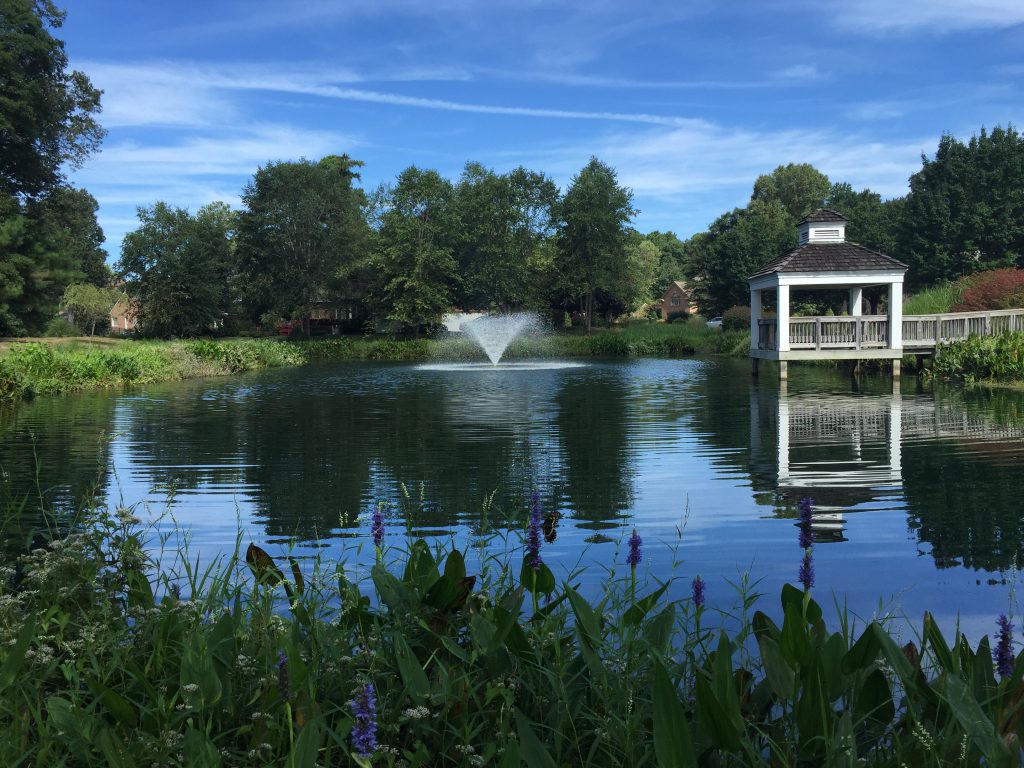
For water quality management professionals that work with stormwater systems on a day to day basis, the basic stormwater management pond parts are easy to identify. Professionals must remember that when most people outside of the water quality management industry read an inspection report or are told that they have a clogged outlet structure or a separated inlet pipe, they may have no idea what that is or how it could impact their pond or BMP. Taking the time to educate a client, on the fundamentals of stormwater management is the first step to developing the type of relationship required to implement a successful stormwater maintenance or repair program.
Contact the experts at 888-480-5253 for your lake, pond, wetland, and fisheries management needs.
SOLitude Lake Management is a nationwide environmental firm committed to providing sustainable solutions that improve water quality, enhance beauty, preserve natural resources and reduce our environmental footprint. SOLitude’s team of aquatic resource management professionals specializes in the development and execution of customized lake, pond, wetland and fisheries management programs that include water quality testing and restoration, nutrient remediation, algae and aquatic weed control, installation and maintenance of fountains and aeration systems, bathymetry, mechanical harvesting and hydro-raking, lake vegetation studies, biological assessments, habitat evaluations, and invasive species management. Services and educational resources are available to clients nationwide, including homeowners associations, multi-family and apartment communities, golf courses, commercial developments, ranches, private landowners, reservoirs, recreational and public lakes, municipalities, drinking water authorities, parks, and state and federal agencies. SOLitude Lake Management is a proud member of the Rentokil Steritech family of companies in North America.









